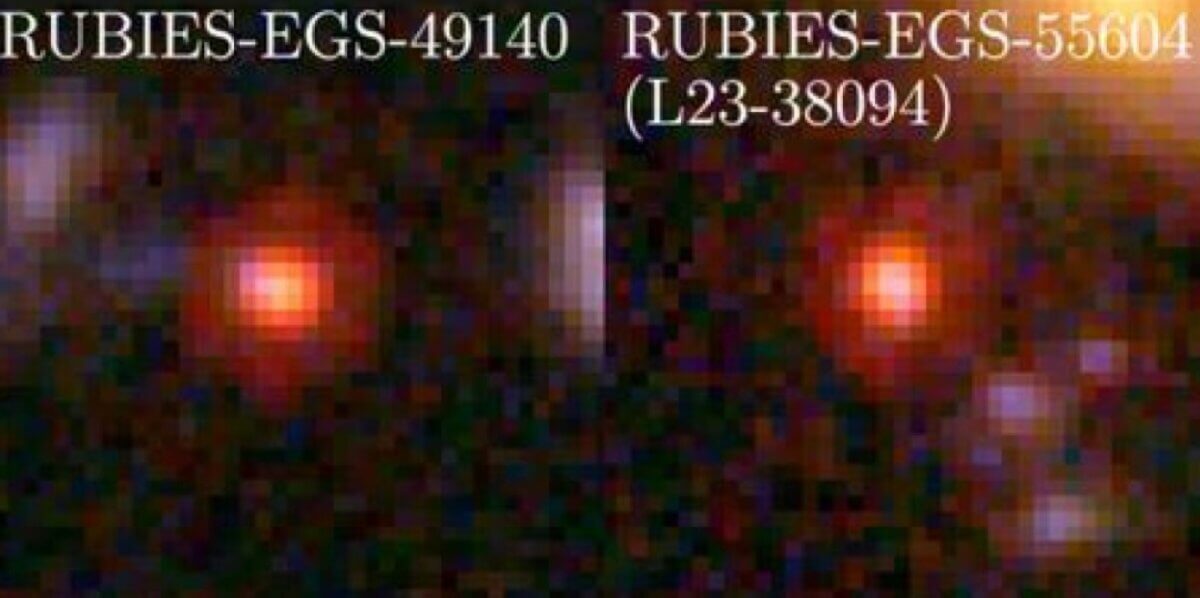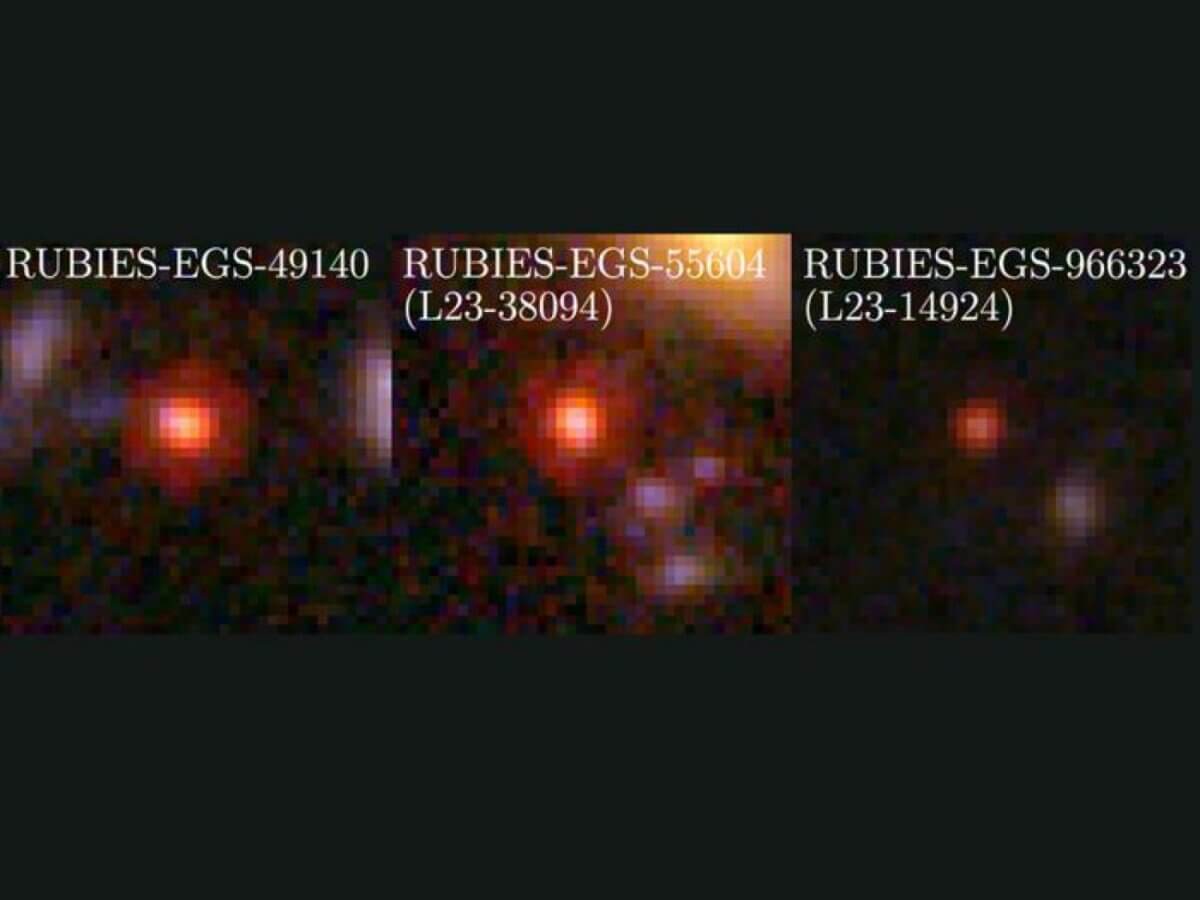
Researchers investigated three mysterious objects in the early universe. Shown here are their color images, composited from three NIRCam filter bands onboard the James Webb Space Telescope. They are remarkably compact at red wavelengths (earning them the term “little red dots”), with some evidence for spatial structure at blue wavelengths. (CREDIT: JWST/NIRSpec.)
Table of contents
UNIVERSITY PARK, Pa. — In a discovery that has left astronomers scratching their heads, the James Webb Space Telescope (JWST) has revealed ancient galaxies that seem impossibly mature for their age. These cosmic relics, existing when the universe was a mere five percent of its current age, are forcing scientists to reconsider fundamental theories about galaxy formation and evolution.
The findings, published in the Astrophysical Journal Letters, detail three mysterious objects observed in the early universe, approximately 600 to 800 million years after the Big Bang. What's perplexing scientists is the presence of characteristics typically associated with much older, more developed galaxies.
“We have confirmed that these appear to be packed with ancient stars — hundreds of millions of years old — in a universe that is only 600-800 million years old. Remarkably, these objects hold the record for the earliest signatures of old starlight,” says Bingjie Wang, a postdoctoral scholar at Penn State and lead author of the study, in a statement. “It was totally unexpected to find old stars in a very young universe. The standard models of cosmology and galaxy formation have been incredibly successful, yet, these luminous objects do not quite fit comfortably into those theories.”
To put this in perspective, imagine encountering a five-year-old child who displayed the wisdom and maturity of a 30-year-old adult. These galaxies are the cosmic equivalent of such a phenomenon, showing characteristics typically associated with much older galactic systems.
The presence of “old” stars in these young galaxies implies that they began forming stars very early in the universe's history, possibly as early as 200 to 300 million years after the Big Bang. This rapid and early star formation challenges current models of galaxy evolution, which generally predict a more gradual build-up of galaxies over time.
Adding to the intrigue, the researchers also found evidence of supermassive black holes within these galaxies, estimated to be 100 to 1,000 times more massive than the one in our Milky Way. The coexistence of these giant black holes with such young galaxies defies our current understanding of how galaxies and their central black holes grow together over billions of years.
“It's very confusing,” says Joel Leja, assistant professor of astronomy and astrophysics at Penn State and co-author of the study. “You can make this uncomfortably fit in our current model of the universe, but only if we evoke some exotic, insanely rapid formation at the beginning of time. This is, without a doubt, the most peculiar and interesting set of objects I've seen in my career.”

The researchers used various models to interpret the data, considering different scenarios for the composition of these galaxies. In one interpretation, these could be early galaxies that are unexpectedly old and more massive even than our own Milky Way. Alternatively, they could be more normal-mass galaxies with “overmassive” black holes.
Another puzzling aspect is the incredibly small sizes of these systems. Despite potentially containing as many stars as our Milky Way (between 10 billion and 1 trillion), these ancient galaxies are packed into a volume about 1,000 times smaller. This extreme density of stars suggests they must have formed under conditions never before observed or expected in the early universe.
These findings have significant implications for our understanding of the early universe. They suggest that the processes of galaxy formation and evolution may have been much more rapid and efficient than previously thought. This could mean that the first galaxies formed earlier than expected or that some unknown mechanism allowed for accelerated growth in the cosmic dawn.
The study also highlights the JWST's power in pushing the boundaries of our observational capabilities. By peering further back in time than ever before, it's allowing astronomers to directly observe the earliest epochs of galaxy formation, providing crucial data to test and refine our models of cosmic evolution.
As we continue to explore the early universe with tools like JWST, we can expect more surprises that challenge our understanding of how the cosmos came to be. These ancient, mature galaxies are likely just the first of many discoveries that will reshape our cosmic origin story.
Methodology
The researchers used data from the JWST's Near-Infrared Spectrograph (NIRSpec) instrument as part of the RUBIES survey. They analyzed the spectral measurements or intensity of different wavelengths of light emitted from the objects. This allowed them to identify signatures of old stars and supermassive black holes. The team then used various models to interpret this data, considering different scenarios for how much of the light comes from stars versus active black holes.
Results
The study found three galaxies in the early universe (600-800 million years after the Big Bang) that show clear signs of mature stellar populations hundreds of millions of years old. These galaxies also show evidence of supermassive black holes 100 to 1,000 times more massive than the one in our Milky Way. The galaxies are incredibly dense, packing a similar number of stars as the Milky Way into a volume 1,000 times smaller.
Limitations
One of the main limitations of this study is the difficulty in distinguishing between light from stars and light from active black holes in these distant galaxies.
“Distinguishing between light from material falling into a black hole and light emitted from stars in these tiny, distant objects is challenging,” Wang notes.
This ambiguity leads to a range of possible interpretations for the masses and ages of these systems. Additionally, the sample size is small, with only three galaxies studied in detail.
Discussion and Takeaways
The discovery of these mature galaxies in the early universe challenges our current models of galaxy formation and evolution. It suggests that either galaxies can form and evolve much more quickly than previously thought or that galaxy formation began even earlier in cosmic history than current models predict. The presence of massive supermassive black holes in these young galaxies also raises questions about how quickly these cosmic giants can form and grow.
These findings highlight the need for further observations of the early universe to determine if these galaxies are common or rare. They also underscore the importance of developing more sophisticated models that can account for rapid early galaxy growth and the co-evolution of galaxies and their central black holes.
“There's another way that we could have a breakthrough, and that's just the right idea. We have all these puzzle pieces and they only fit if we ignore the fact that some of them are breaking. This problem is amenable to a stroke of genius that has so far eluded us, all of our collaborators and the entire scientific community,” Leja concludes.










